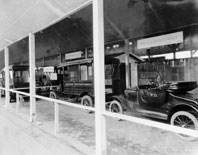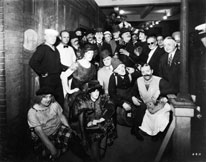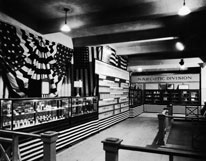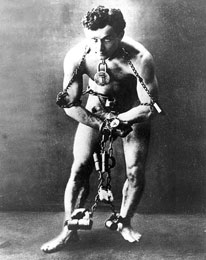Exhibition: A Pictorial Review, Greater New York's Silver Jubilee, May 26-June 23, 1923
A Digital Initiatives Department Exhibit, B. Davis Schwartz Memorial Library, February 14-March 20, 2011.
- Documentation of the Exhibit
- Jubilee
- Education
- NYC Fire Department
- NYC Police Department
- NYC Street Cleaning
New York City Police Department

Exhibit on Park Avenue: Types of vehicle equipment used by the Department (wrh_pr2_131.tif)
Commissioner Richard E. Enright was appointed in 1918 by Mayor John F. Hylan as chief executive officer of the Police Department. Enright, as the first Commissioner to rise from the rank and file, served during New York’s Silver Jubilee and remained in office until his resignation in 1925. Enright was fully responsible for the execution of all laws and regulations of his Department. The Department was primarily charged with preserving the public peace, preventing crimes, arresting offenders, suppressing riots, controlling traffic, arresting beggars and mendicants, protecting immigrants and travelers, and suppressing houses of “ill fame,” vice and gambling. The Department also took great pride in raising money for the destitute widows and children of fallen officers. By April 1st 1923, the New York City Police force has grown to 12, 210 yet the increase did not keep pace with the growth of the city. Among the City’s most complex problems, thirty nine percent of the population was foreign born and a large part of the population did not speak or read English.
Under Enright, members of the Police Department were called upon to sell tickets for the City’s Silver Jubilee. On May 23rd, 1923, tickets were distributed to patrolmen who in turn sold them to shopkeepers and friends on the beat. Traffic police were also given a batch of tickets to be sold to passing motorists. In all, policemen were expected to sell at least 20 tickets at 50 cents each and to buy two for their own use. A number of civil servants were disgruntled by the pressure to sell tickets. Others who had bought tickets thought it unfair that their tickets were good for only one particular night. While no official order to buy or sell tickets had gone forth, Grover A. Whalen, Commissioner of the Department of Plant and Structures and Vice Chairman of the Jubilee Committee, was quoted in the New York Times the following day stating that he hoped every city official will be interested enough to attend the educational exposition and learn all he could about the city in which he lives and works.

Old Bowery scene: Members of the Police Glee Club and Band who nightly illustrated scenes on the Old Bowery of 25 years ago. (wrh_pr2_129.tif)
The Police Department Exhibit featured images of old and contemporary New York Bowery scenes and other famous landmarks and familiar places. Old tunes were played on a hurdy-gurdy (a mechanical musical instrument that is played by turning a handle) and members of the Police Glee Club and Band nightly illustrated Old Bowery scenes. Prior to the consolidation of the City in 1898, there was no Police Glee Club or Band. Organized in 1901, the Police Band took on the role of performing free concerts for charity and by 1925 it had become the official band of the City of New York. On June 12th, 1923, “Vaudeville Day” at the Silver Jubilee, E.F. Albee, a member of the Vaudeville Managers' Association, planned the afternoon and evening events. The Police and Fire Department Bands and the Street Cleaning Department Glee Club provided the music.

Included in the Narcotics Division exhibit were various modern and ancient opium and drug pipes, probably the finest collection of its kind in existence. (wrh_pr2_116.tif)
The Narcotics Division of the Police Department exhibited the work done on assembling the criminal records of drug violators, an educational display of various drugs and their derivatives, and a display of the paraphernalia and instruments used by “underworld addicts.” The new Narcotics Division was established under Commissioner Enright to suppress the illicit trafficking and use of narcotic drugs. It was the first organization of its kind in the United States. The Division attracted much attention because of the number of drug addicts apprehended and the vast amount of narcotic drugs seized and destroyed. The Narcotics Division was considered extraordinarily efficient in carrying out Enright’s vision of New York as the world’s safest city.

Harry Houdini; AP File Photo
Image ID: 061206049563 (houdini.jpg)
A special event of the City’s Silver Jubilee was planned for June 11th, 1923 where Harry Houdini (1874-1926) would match his skills as a great escape artist against expert members of the Police Department’s detective squad. Houdini was placed in a straight-jacket and chains and hoisted high over the Grand Central Palace where he was expected to free himself in view of those watching from the street. The following day, the event was reported in the New York Times. “Houdini gave an open-air exhibition, suspended forty feet above Park Avenue. He wriggled free from bonds placed upon him by expert members of the Police Department. Houdini said it was one of his most severe tests.” Houdini performed a similar stunt in Oakland California that same year, one that was repeated by escape artist and magician Steve Baker in 1967. Baker, confined by a straight jacket, was hoisted from the Oakland Tribune Tower. Baker escaped in just nine seconds.
